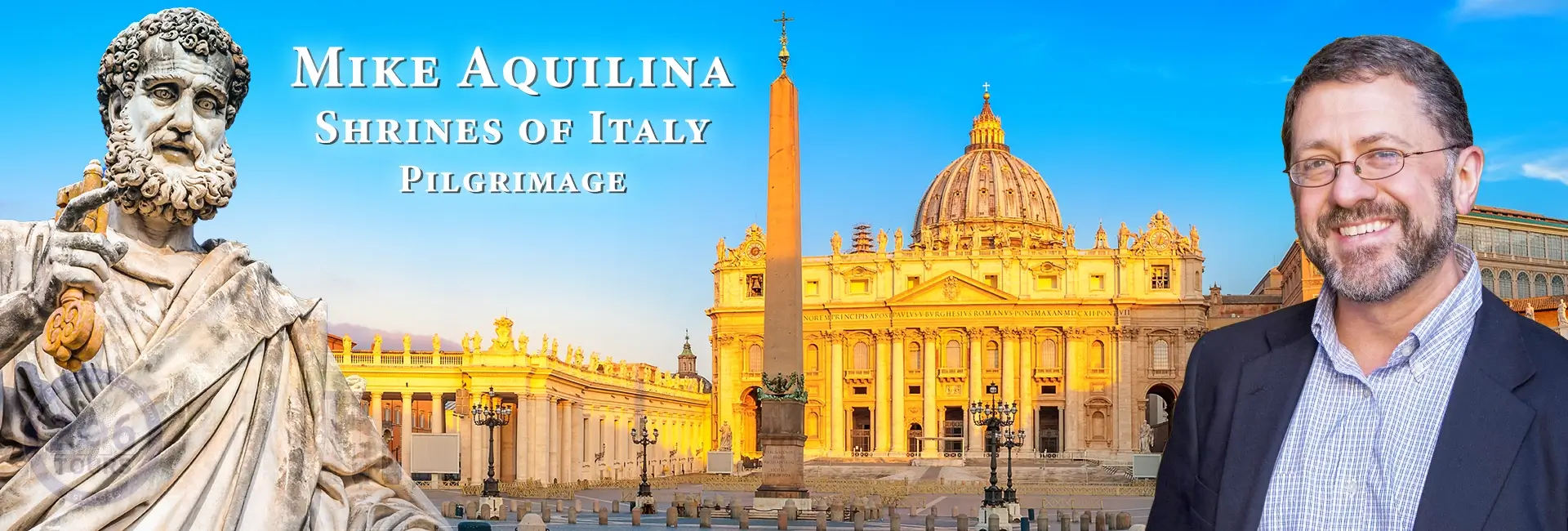What is a Pilgrimage by Michael Aquilina
Gaudiamus omnes indomino, Diem festum celebrantes, Sub honore Santorum omnium.
In this episode, we’re talking about Pilgrimage. Christianity, unlike other world religions, has never mandated Pilgrimage. In Judaism, it was a requirement. The Law of Moses compelled Israelite males to make three trips to Jerusalem every year for Passover, Pentecost, and Sukkot. You can find the mandate in Exodus chapters 23 and 34, and again in Deuteronomy chapter 16. The Lord said to Moses, Three times in the year you shall keep a feast to me. Three times in the year shall all your males appear before the Lord God. Three times a year all your males shall appear before the Lord your God at the place which he will choose, at the feast of unleavened bread, at the feast of weeks, and at the feast of booths. They shall not appear before the Lord empty-handed. The ancient historians tell us that in the early first century, the population of Jerusalem doubled during these holidays as Jews arrived from all the nations of the known world. You can catch a glimpse of it in the Acts of the Apostles chapters 2 and 9.
Pilgrimage is important to Judaism. Pilgrimage is central to Islam as well. It’s the fifth pillar of Islam. Muslims are duty-bound to make the Hajj, the Trekk to Mecca, at least once in their lifetime, and some 2.5 million people complete the journey every year. So for ancient Jews and modern Muslims, Pilgrimage has occupied a place that’s comparable to the place of the sacraments in Catholic tradition. It’s customary in Hinduism as well. The Church, however, has never claimed such a place for Pilgrimage. The New Testament doesn’t require it. Canon law has never mandated it. No catechism has ever presented it dogmatically. Yet Christians have always done it. And in great numbers. That’s clear from the documents of the early Church. It’s evident also in the archaeological remains from that period.
Let’s consider why this might be so. We’ll start by defining our key term. A pilgrimage is a journey undertaken for a religious purpose. A journey undertaken for a religious purpose. And it’s a prominent motif in the Gospels. From at least his adolescence, Jesus fulfilled the command to celebrate the festivals in Jerusalem. It was his family’s custom, we’re told, in Luke chapter 2 verse 42. And the trip from Nazareth on foot, on crowded roads, probably took between four and six days each way. In adulthood, Jesus continued the practice, not out of a sense of obligation, but rather out of love. It was his earnest desire, he says in Luke 22.15. And he set out for Jerusalem with determination, as we’re told in Luke 9.51. These journeys were so important to Jesus that St. John uses them as the dominant structural element in the composition of his Gospel. The Apostle Paul, even after his conversion to the way of Jesus Christ, continued to make pilgrimage to Jerusalem for Pentecost, as we can see in Acts 20 verse 16. And the early Church Fathers followed his example. St. Melito of Sardis, in the mid-100s, made his way to the Holy Land in order to enrich his understanding of the Scriptures. A few decades later, the Egyptian scholar, Origen, made his own sojourn in Palestine and visited the sacred sites.
The early Christians turned up at the sites in such numbers that the Romans took extreme measures to discourage the practice. The Emperor Hadrian ordered that the cave of Jesus’ Nativity be buried and a grove planted over it. He dedicated the grove to the god Adonis. Every deterrent was in place, but believers visited anyway.
As the Church spread outward from Jerusalem, Christians made their way to other pilgrim destinations. There was Rome, of course. St. Paul himself was led inexorably toward the Empire’s capital. We see that in the Acts of the Apostles and in Paul’s own letter to the Romans. St. Peter was too. Both men sanctified the ground there by their martyrdom, and so their blood exerted a magnetic attraction to Christians across the earth and sea. Almost all the early Christians about whom we know anything are saints we know to have made a Roman pilgrimage. Ignatius came from Antioch to Syria around 105 AD. Polycarp came from Smyrna, Izmir in modern Turkey, just a few years later. Justin came from Nablus in Palestine. Irenaeus came from Lyon. Origen came from Alexandria and Egypt. All went wayfaring to Rome, making pilgrimage for a variety of reasons. Ignatius went there to die. Polycarp went to see the Pope. Justin went to start a school. Irenaeus went for peace in the church. Origen went to sit at the feet of a great biblical scholar.
In the very generation after the Apostles, St. Ignatius of Antioch felt himself to be propelled toward Rome, to die there as a martyr, but also to pay his respects to that place that was already regarded as the religious capital of Christianity. The church, as he put it, that presides in the place of the region of the Romans, worthy of God, worthy of honor, worthy of the highest happiness, worthy of praise, worthy of obtaining her every desire, worthy of being deemed holy, and which presides over love.
Along with celebrities like Ignatius came thousands of others. They are the great anonymous crowd of a typical parish. People like you and me. Here comes everybody. And they left their mark, literally. They scratched graffiti into the plaster and soft stone at the tombs of the Apostles and martyrs. You can still see it there today. It says, Peter and Paul, pray for Victor. Martyrs and saints, keep Maria in mind. Oh, Hippolytus, remember Peter, a sinner. Master Crescencio, heal my eyes for me. Oh, Saint Sixtus, remember Aurelius Rampantinus in your prayers. Oh, Holy Souls, remember Marcianus, Succesus, Severus, and all our brethren. These are the prayers of pilgrims.
In the fourth century, Saint Jerome traveled from Croatia to Rome to pursue his studies. He was a good student, but not particularly devout. Then he began to spend his Sundays wandering with the torch through the dark tunnels of the catacombs. Curiosity brought him there, but devotion made him go back. And he kept going back. He made it a weekly pilgrimage, and in the catacombs, he prayed the prayers that made him a saint. Later in life, Jerome would make his voyage to Jerusalem, along with an entourage from Rome. His companions included the female scholars Paula and Eustochium, who founded a convent. Together they would become history’s most ardent promoters of religious tourism to the Holy Land.
Jerome describes the effect such an excursion had on Saint Paula. Quote, she started to go round visiting all the places with such burning enthusiasm that there was no taking her away from one unless she was hurrying on to another. She fell down and worshiped before the cross as if she could see the Lord hanging on it. On entering the tomb of the resurrection, she kissed the stone which the angel removed from the sepulcher door. Then, like a thirsty man who has waited long and at last comes to water, she faithfully kissed the very shelf on which the Lord’s body had lain. Her tears there were known to all Jerusalem, or rather to the Lord himself to whom she was praying. End of quote.
These were the gestures of an ancient pilgrim, and Christians still observe them today. Shortly after the Emperor Constantine legalized Christianity in 313, his mother Helena went abroad to see the holy places described in the scriptures. In Jerusalem and Bethlehem, she commissioned the construction of great basilicas in honor of the Savior. Soon Christians from everywhere came to throng these places, and they continue to do so today. Believers also made pilgrimage to living saints and living sages.
Saint Anthony of Egypt strove to live in the desert in poverty and solitude, but he was visited daily by the devout, the inquisitive, and the curious who sought his advice or just his blessing. So diverse were the pilgrims coming from every direction that Anthony had to keep translators at hand, drawn from the monasteries nearby.
So why did the early Christians do this, even though they didn’t have to? Even though it was the subject of no commandment, requirement, or obligation. They did it because Jesus had done it, and they wanted to follow his example. They did it because Saint Paul had done it, the same Saint Paul who had said, be imitators of me, as I am of Christ. They did it because Policarp had, and Irenaeus, and Melito, and Origen, and Jerome. The Fathers knew our faith is not about myths or fairy tales. It’s not about something that happened once upon a time or longer than something that happened once upon a time or long ago in a galaxy far, far away. It’s about a real person who lived in a real place at a specific time in history. You could point to the place on a map. You could place the dates on a timeline. And pilgrimage is about the Church of Jesus Christ and his saints who lived at specific times in specific places down through the ages.
Pilgrimage is real. It’s gritty and earthy, and it involves discomforts, freely accepted. Pilgrims jostle for their place as the crowds form a line at the holy sites. The guards look bored today as they did in Rome or Jerusalem in 375 AD. But all of this is as it should be. Surely that’s how it was for Jesus on his periodic trips to the holy city. But Jesus made pilgrimage anyway. He also made pilgrimage to the Holy Land. He undertook his hardships for us. In fact, his very incarnation can be seen as a pilgrimage he made for our sake, a journey for a religious purpose. He went forth from the bosom of his heavenly father to be with his people in Jerusalem and to sanctify the roads and rivers nearby. And down to our own day, Christians continue his pilgrim way. The way of the Fathers.
So, in October of 2023, I’ll be leading such a pilgrimage to Rome and other sites nearby. It will run from October 9th to 18th. I hope you’ll consider joining me and walking the way of the Fathers. For more details, click the link in the program notes for this episode, or visit pilgrimages.com and search on my name, Mike Aquilina
I hope you’ve enjoyed this episode of The Way of the Fathers. If you did, I ask you to consider making a donation to help us. Consider even making a monthly donation. Our sponsor, catholicculture.org, is run by Trinity Communications, a nonprofit organization. So, donations are tax deductible in the United States. So, please go now to our donation form at catholicculture.org slash donate slash audio. We’re grateful for anything you can give, and we pray for our benefactors every day. The Way of the Fathers is a production of catholicculture.org. Check out our other podcasts, including Catholic Culture Audiobooks, bringing to life classic Catholic writings, Criteria, the Catholic Film Podcast, featuring deep analysis of great films from a Catholic perspective, and the Catholic Culture Podcast, an interview show exploring Catholic arts, culture, and issues. You’ll find all of this, as well as Catholic news, commentary, liturgical year resources, and much more at catholicculture.org.


